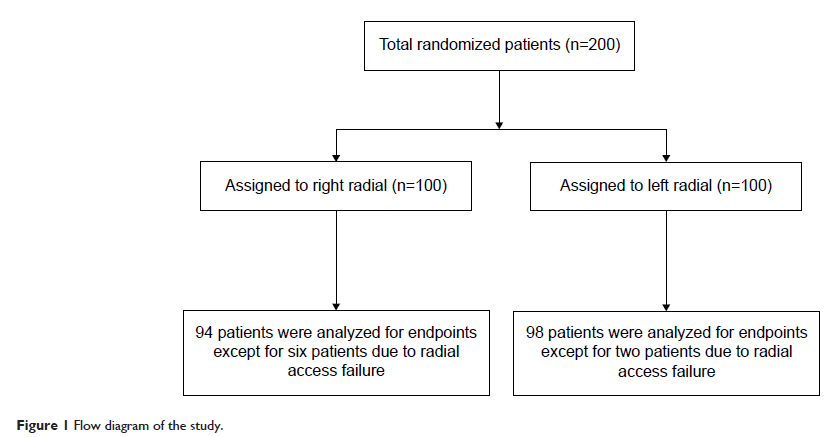109669
论文已发表
注册即可获取德孚的最新动态
IF 收录期刊
- 3.4 Breast Cancer (Dove Med Press)
- 3.2 Clin Epidemiol
- 2.6 Cancer Manag Res
- 2.9 Infect Drug Resist
- 3.7 Clin Interv Aging
- 5.1 Drug Des Dev Ther
- 3.1 Int J Chronic Obstr
- 6.6 Int J Nanomed
- 2.6 Int J Women's Health
- 2.9 Neuropsych Dis Treat
- 2.8 OncoTargets Ther
- 2.0 Patient Prefer Adher
- 2.2 Ther Clin Risk Manag
- 2.5 J Pain Res
- 3.0 Diabet Metab Synd Ob
- 3.2 Psychol Res Behav Ma
- 3.4 Nat Sci Sleep
- 1.8 Pharmgenomics Pers Med
- 2.0 Risk Manag Healthc Policy
- 4.1 J Inflamm Res
- 2.0 Int J Gen Med
- 3.4 J Hepatocell Carcinoma
- 3.0 J Asthma Allergy
- 2.2 Clin Cosmet Investig Dermatol
- 2.4 J Multidiscip Healthc

已发表论文
经左右桡尺动脉行直接经皮冠状动脉介入治疗 ST 段抬高心肌梗死的随机对照研究
Authors Fu Q, Hu H, Wang D, Chen W, Tan Z, Li Q, Chen B
Published Date June 2015 Volume 2015:10 Pages 1003—1008
DOI http://dx.doi.org/10.2147/CIA.S81568
Received 25 January 2015, Accepted 30 April 2015, Published 24 June 2015
Approved for publication by Professor Zhi-Ying Wu
Background: Growing evidence suggests that the left radial approach (LRA) is related to decreased coronary procedure duration and fewer cerebrovascular complications as compared to the right radial approach (RRA) in elective percutaneous coronary intervention (PCI). However, the feasibility of LRA in primary PCI has yet to be studied further. Therefore, the aim of this study was to investigate the efficacy of LRA compared with RRA for primary PCI in ST-elevation myocardial infarction (STEMI) patients.
Materials and methods: A total of 200 consecutive patients with STEMI who received primary PCI were randomized to LRA (number [n]=100) or RRA (n=100). The study endpoint was needle-to-balloon time, defined as the time from local anesthesia infiltration to the first balloon inflation. Radiation dose by measuring cumulative air kerma (CAK) and CAK dose area product, as well as fluoroscopy time and contrast volume were also investigated.
Results: There were no significant differences in the baseline characteristics between the two groups. The coronary procedural success rate was similar between both radial approaches (98% for left versus 94% for right; P =0.28). Compared with RRA, LRA had significantly shorter needle-to-balloon time (16.0±4.8 minutes versus 18.0±6.5 minutes, respectively; P =0.02). Additionally, fluoroscopy time (7.4±3.4 minutes versus 8.8±3.5 minutes, respectively; P =0.01) and CAK dose area product (51.9±30.4 Gy cm2 versus 65.3±49.1 Gy cm2, respectively; P =0.04) were significantly lower with LRA than with RRA.
Conclusion: Primary PCI can be performed via LRA with earlier blood flow restoration in the infarct-related artery and lower radiation exposure when compared with RRA; therefore, the LRA may become a feasible and attractive alternative to perform primary PCI for STEMI patients.
Keywords: transradial approach, primary percutaneous coronary intervention, ST-segment elevation myocardial infarction
Materials and methods: A total of 200 consecutive patients with STEMI who received primary PCI were randomized to LRA (number [n]=100) or RRA (n=100). The study endpoint was needle-to-balloon time, defined as the time from local anesthesia infiltration to the first balloon inflation. Radiation dose by measuring cumulative air kerma (CAK) and CAK dose area product, as well as fluoroscopy time and contrast volume were also investigated.
Results: There were no significant differences in the baseline characteristics between the two groups. The coronary procedural success rate was similar between both radial approaches (98% for left versus 94% for right; P =0.28). Compared with RRA, LRA had significantly shorter needle-to-balloon time (16.0±4.8 minutes versus 18.0±6.5 minutes, respectively; P =0.02). Additionally, fluoroscopy time (7.4±3.4 minutes versus 8.8±3.5 minutes, respectively; P =0.01) and CAK dose area product (51.9±30.4 Gy cm2 versus 65.3±49.1 Gy cm2, respectively; P =0.04) were significantly lower with LRA than with RRA.
Conclusion: Primary PCI can be performed via LRA with earlier blood flow restoration in the infarct-related artery and lower radiation exposure when compared with RRA; therefore, the LRA may become a feasible and attractive alternative to perform primary PCI for STEMI patients.
Keywords: transradial approach, primary percutaneous coronary intervention, ST-segment elevation myocardial infarction
